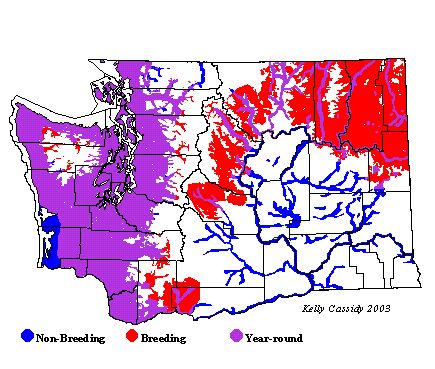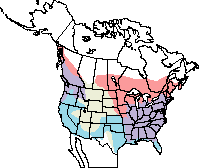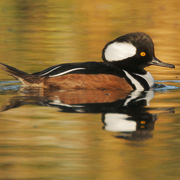Hooded Merganser
General Description
This duck is the smallest merganser commonly found in Washington. Hooded Mergansers have a crest that, like a fan, can be spread or closed. Like other mergansers, it has a narrow, serrate bill. The male in breeding plumage is distinctive, with olive-brown sides and a black back accented with white stripes down the middle of a few long feathers. His breast is white with two black bars on each side. The black border surrounding the white crest extends to the face, which is punctuated with a yellow eye. Females are brown-gray overall, lighter below and darker on the back. The crest of the female is reddish-brown. The juvenile looks like the female, as does the male in non-breeding plumage, although his crest is browner.
Habitat
Small, forested, freshwater wetlands with emergent vegetation are the preferred breeding habitat of the Hooded Merganser. They have been known to breed in more open habitat when nest boxes are available. Low-elevation freshwater lakes, ponds, sloughs, and slow-moving rivers are all used. During migration, they visit a wider range of habitats, and are often found on open water, along river banks, and in coastal bays and tidal creeks. In winter, they are found in woodland ponds and swamps, as well as coastal estuaries, bays, and inlets. While they are found in brackish and salt water, they generally prefer fresh water.
Behavior
The dramatic courtship displays of the Hooded Merganser are apparent on the wintering grounds where groups gather in small flocks and most pair formation begins. During these displays, the male fans his crest.
Diet
Hooded Mergansers have a more diverse diet than that of other mergansers. Small fish, crustaceans--especially crayfish, and aquatic insects are all common prey items. Insects are especially important for the young. Hooded Mergansers have underwater vision, which helps them forage while diving.
Nesting
Yearling females often prospect for potential nest sites for the following year, and generally start breeding at the age of two. Pair bonds last from winter until incubation begins. It is uncertain whether bonds reform the following year, or if all pairing begins anew. Hooded Mergansers nest in cavities 10 to 50 feet up a tree or in nest boxes. The nest is made from materials found in the cavity and lined with down. The female lays 10 to 12 eggs, and commonly lays eggs in the nests of other Hooded Mergansers and those of other cavity-nesting ducks. Incubation is by the female alone and lasts for 26 to 41 days, averaging 33 days. When incubation starts, the male leaves the nesting area. Within 24 hours of hatching, the young jump to the ground and head to the water. Here they can swim well and find their own food. The female tends them and leads them to food-rich areas for a few weeks, but abandons them before they can fly, at around 70 days.
Migration Status
Hooded Mergansers migrate short distances. They have usually left coastal wintering areas by April and return in mid-November.
Conservation Status
Habitat destruction and the loss of nesting cavities have undoubtedly resulted in a decline, although in recent decades numbers have stabilized and appear to be on the increase in many areas with the help of nest boxes and wetland-restoration efforts. Hooded Mergansers have a relatively small population and low productivity rates due to their delayed onset of breeding (not breeding until age two). They are also slow to colonize new breeding areas, making it more important to conserve the areas where this duck is currently breeding.
When and Where to Find in Washington
In the summer, Hooded Mergansers are generally found in wooded lowland areas throughout Washington. They are absent from the flat and sandy southwestern coast of the state, mountains above 3,000 feet, and the Columbia Basin. They are fairly common breeders in suitable habitat in western Washington. In eastern Washington, they are more sporadically distributed along the northern river valleys, particularly along the Okanogan River (Okanogan County), Curlew Creek (Ferry County), Colville River (Stevens County), and Pend Oreille River (Pend Oreille County). In winter, they are common in appropriate habitat in western Washington, along the coast, and in the wetlands of the Columbia Basin.
 Abundance
Abundance
| Ecoregion | Jan | Feb | Mar | Apr | May | Jun | Jul | Aug | Sep | Oct | Nov | Dec |
|---|---|---|---|---|---|---|---|---|---|---|---|---|
| Oceanic | ||||||||||||
| Pacific Northwest Coast | U | U | U | U | U | R | R | U | U | U | U | U |
| Puget Trough | F | F | C | F | F | F | F | F | F | F | C | C |
| North Cascades | F | F | F | F | F | U | U | U | U | F | F | F |
| West Cascades | F | F | F | F | F | F | F | F | F | F | F | F |
| East Cascades | C | F | F | F | U | R | R | R | U | F | F | C |
| Okanogan | U | U | U | U | U | U | U | U | U | U | U | U |
| Canadian Rockies | F | F | F | U | U | U | U | U | U | U | F | F |
| Blue Mountains | R | R | R | |||||||||
| Columbia Plateau | U | U | U | U | R | U | F | F | F |
Washington Range Map

North American Range Map


Family Members
 Fulvous Whistling-DuckDendrocygna bicolor
Fulvous Whistling-DuckDendrocygna bicolor Taiga Bean-GooseAnser fabalis
Taiga Bean-GooseAnser fabalis Greater White-fronted GooseAnser albifrons
Greater White-fronted GooseAnser albifrons Emperor GooseChen canagica
Emperor GooseChen canagica Snow GooseChen caerulescens
Snow GooseChen caerulescens Ross's GooseChen rossii
Ross's GooseChen rossii BrantBranta bernicla
BrantBranta bernicla Cackling GooseBranta hutchinsii
Cackling GooseBranta hutchinsii Canada GooseBranta canadensis
Canada GooseBranta canadensis Mute SwanCygnus olor
Mute SwanCygnus olor Trumpeter SwanCygnus buccinator
Trumpeter SwanCygnus buccinator Tundra SwanCygnus columbianus
Tundra SwanCygnus columbianus Wood DuckAix sponsa
Wood DuckAix sponsa GadwallAnas strepera
GadwallAnas strepera Falcated DuckAnas falcata
Falcated DuckAnas falcata Eurasian WigeonAnas penelope
Eurasian WigeonAnas penelope American WigeonAnas americana
American WigeonAnas americana American Black DuckAnas rubripes
American Black DuckAnas rubripes MallardAnas platyrhynchos
MallardAnas platyrhynchos Blue-winged TealAnas discors
Blue-winged TealAnas discors Cinnamon TealAnas cyanoptera
Cinnamon TealAnas cyanoptera Northern ShovelerAnas clypeata
Northern ShovelerAnas clypeata Northern PintailAnas acuta
Northern PintailAnas acuta GarganeyAnas querquedula
GarganeyAnas querquedula Baikal TealAnas formosa
Baikal TealAnas formosa Green-winged TealAnas crecca
Green-winged TealAnas crecca CanvasbackAythya valisineria
CanvasbackAythya valisineria RedheadAythya americana
RedheadAythya americana Ring-necked DuckAythya collaris
Ring-necked DuckAythya collaris Tufted DuckAythya fuligula
Tufted DuckAythya fuligula Greater ScaupAythya marila
Greater ScaupAythya marila Lesser ScaupAythya affinis
Lesser ScaupAythya affinis Steller's EiderPolysticta stelleri
Steller's EiderPolysticta stelleri King EiderSomateria spectabilis
King EiderSomateria spectabilis Common EiderSomateria mollissima
Common EiderSomateria mollissima Harlequin DuckHistrionicus histrionicus
Harlequin DuckHistrionicus histrionicus Surf ScoterMelanitta perspicillata
Surf ScoterMelanitta perspicillata White-winged ScoterMelanitta fusca
White-winged ScoterMelanitta fusca Black ScoterMelanitta nigra
Black ScoterMelanitta nigra Long-tailed DuckClangula hyemalis
Long-tailed DuckClangula hyemalis BuffleheadBucephala albeola
BuffleheadBucephala albeola Common GoldeneyeBucephala clangula
Common GoldeneyeBucephala clangula Barrow's GoldeneyeBucephala islandica
Barrow's GoldeneyeBucephala islandica SmewMergellus albellus
SmewMergellus albellus Hooded MerganserLophodytes cucullatus
Hooded MerganserLophodytes cucullatus Common MerganserMergus merganser
Common MerganserMergus merganser Red-breasted MerganserMergus serrator
Red-breasted MerganserMergus serrator Ruddy DuckOxyura jamaicensis
Ruddy DuckOxyura jamaicensis

